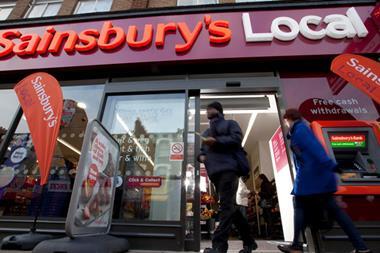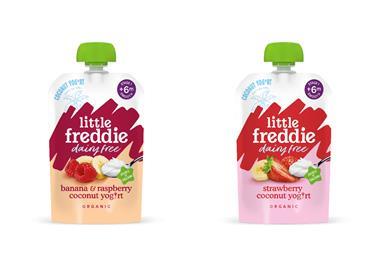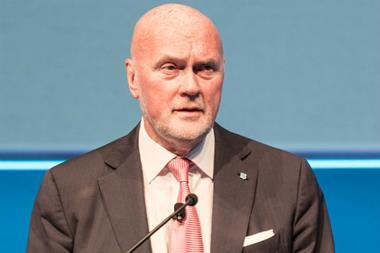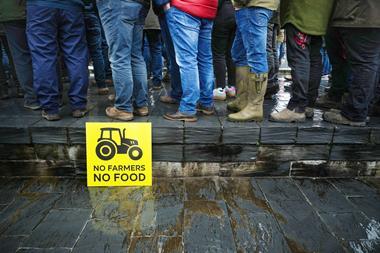>>physical activity should be accessible to all children. Justin King, CEO of Sainsbury
The childhood obesity debate continues to rage on. In the grocery industry, we’re used to people thinking that diet is fundamentally the cause, but clear links also exist between the levels of exercise children take and the state of their health. Surprisingly, we’re actually eating 750 fewer calories a day than we did 20 years ago, but because we’re less active, we’re getting heavier.
As retailers, and parents, we want to keep our children fit, healthy and happy. In addition to healthy diets, we can encourage children to increase their levels of activity.
The Department of Culture, Media and Sport and the Department for Education and Skills have collaborated on an initiative, which aims to raise from 25% in 2002 to 85% by 2008 the number of children who spend a minimum of two hours a week on physical education and sport. Dame Kelly Holmes was named this month as the government’s first national School Sport Champion and is supporting the initiative, and continuing to be Sainsbury’s Active Kids ambassador.
Sadly, despite the government’s objectives, participation in school sport remains significantly behind these targets. In secondary schools, research shows that 70% of pupils are not engaged in sport and that teenage girls are the least active. There is a strong culture in schools of “only if you’re good enough”; Active Kids last year sought to challenge that by making physical activity accessible to all. You don’t have to excel at sport to get active. That’s why we offer schools more than 400 pieces of equipment. This year, we are supplying coaches who can teach children non-core sport such as keep fit, dance and martial arts.
Last year, through Active Kids, we donated £17m of sports equipment to schools across the country. More than 25,000 schools registered for the scheme - this is 80% of all UK schools. On average, each school that made an order received £754 of
sports equipment. Bearing in mind that the annual PE budget for an average primary school is £200, we’re making a significant difference.
Stores were paramount in making the scheme a success - we heard countless stories of store managers getting out into the community, engaging families and personally delivering shipments of Active Kids equipment to their local schools.
But responsibility for raising children’s activity levels doesn’t just lie with schools. As parents we are the most important factor in determining the fitness of our children, says research. More than 70% of children claim that if their parents were more active, this would encourage them to follow suit. Worryingly, 40% of children say their parents do no or very little exercise; only one in ten say their parents are really active.
It would be wrong not to consider the role of diet. The National Food Survey shows that household energy intakes have fallen since 1970, accompanied by a change in the type of food consumed. Children are eating more than the recommended levels of saturated fat, salt and sugar, and not enough healthy food. Across the UK, young people (aged 4-18) are eating less than half the recommended five portions of fruit and vegetables a day. There is still much confusion among consumers about what foods are actually healthy. As retailers, it is our responsibility to make healthy eating choices as straightforward as possible.
Food labelling is another hot topic. At Sainsbury we colour-code our products: nutritional information is displayed on the front of packaging as a Wheel of Health. We believe it is honest and transparent. It also means making hard calls about labelling and accepting that customers may decide not to buy a particular product.
Through Active Kids we’re increasing levels of activity among children. There’s a real potential that positive active lifestyles that started in childhood may track through to adulthood. That’s what it comes down to. We’re not trying to train up Olympians. We want to get kids up and about by making exercise fun and accessible to all.
The childhood obesity debate continues to rage on. In the grocery industry, we’re used to people thinking that diet is fundamentally the cause, but clear links also exist between the levels of exercise children take and the state of their health. Surprisingly, we’re actually eating 750 fewer calories a day than we did 20 years ago, but because we’re less active, we’re getting heavier.
As retailers, and parents, we want to keep our children fit, healthy and happy. In addition to healthy diets, we can encourage children to increase their levels of activity.
The Department of Culture, Media and Sport and the Department for Education and Skills have collaborated on an initiative, which aims to raise from 25% in 2002 to 85% by 2008 the number of children who spend a minimum of two hours a week on physical education and sport. Dame Kelly Holmes was named this month as the government’s first national School Sport Champion and is supporting the initiative, and continuing to be Sainsbury’s Active Kids ambassador.
Sadly, despite the government’s objectives, participation in school sport remains significantly behind these targets. In secondary schools, research shows that 70% of pupils are not engaged in sport and that teenage girls are the least active. There is a strong culture in schools of “only if you’re good enough”; Active Kids last year sought to challenge that by making physical activity accessible to all. You don’t have to excel at sport to get active. That’s why we offer schools more than 400 pieces of equipment. This year, we are supplying coaches who can teach children non-core sport such as keep fit, dance and martial arts.
Last year, through Active Kids, we donated £17m of sports equipment to schools across the country. More than 25,000 schools registered for the scheme - this is 80% of all UK schools. On average, each school that made an order received £754 of
sports equipment. Bearing in mind that the annual PE budget for an average primary school is £200, we’re making a significant difference.
Stores were paramount in making the scheme a success - we heard countless stories of store managers getting out into the community, engaging families and personally delivering shipments of Active Kids equipment to their local schools.
But responsibility for raising children’s activity levels doesn’t just lie with schools. As parents we are the most important factor in determining the fitness of our children, says research. More than 70% of children claim that if their parents were more active, this would encourage them to follow suit. Worryingly, 40% of children say their parents do no or very little exercise; only one in ten say their parents are really active.
It would be wrong not to consider the role of diet. The National Food Survey shows that household energy intakes have fallen since 1970, accompanied by a change in the type of food consumed. Children are eating more than the recommended levels of saturated fat, salt and sugar, and not enough healthy food. Across the UK, young people (aged 4-18) are eating less than half the recommended five portions of fruit and vegetables a day. There is still much confusion among consumers about what foods are actually healthy. As retailers, it is our responsibility to make healthy eating choices as straightforward as possible.
Food labelling is another hot topic. At Sainsbury we colour-code our products: nutritional information is displayed on the front of packaging as a Wheel of Health. We believe it is honest and transparent. It also means making hard calls about labelling and accepting that customers may decide not to buy a particular product.
Through Active Kids we’re increasing levels of activity among children. There’s a real potential that positive active lifestyles that started in childhood may track through to adulthood. That’s what it comes down to. We’re not trying to train up Olympians. We want to get kids up and about by making exercise fun and accessible to all.



















No comments yet